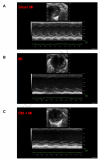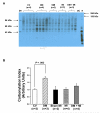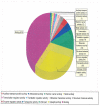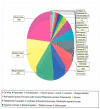Augmented cardiac formation of oxidatively-induced carbonylated proteins accompanies the increased functional severity of post-myocardial infarction heart failure in the setting of type 1 diabetes mellitus
- PMID: 23566587
- PMCID: PMC3707938
- DOI: 10.1016/j.carpath.2013.03.001
Augmented cardiac formation of oxidatively-induced carbonylated proteins accompanies the increased functional severity of post-myocardial infarction heart failure in the setting of type 1 diabetes mellitus
Abstract
Summary: Heart failure (HF) is a dominant cause for the higher mortality of diabetics after myocardial infarction (MI). In the present investigation, we have discovered that higher levels of oxidative stress (OS)-induced carbonylated proteins accompany worsening post-MI HF in the presence of type 1 diabetes. These findings provide a mechanistic link between amplified OS and exacerbation of post-infarction HF in diabetes.
Background: Type 1 diabetes mellitus (DM) patients surviving myocardial infarction (MI) manifest an increased incidence of subsequent heart failure (HF). We have previously shown that after MI, type 1 DM is associated with accentuated myocardial oxidative stress (OS) and concomitant worsening of left ventricular (LV) function. However, the precise mechanisms whereby type 1 DM-enhanced OS adversely affects HF after MI remain obscure. As carbonylation of proteins is an irreversible post-translational modification induced only by OS that often leads to the loss of function, we analyzed protein-bound carbonyls in the surviving LV myocardium of MI and DM+MI rats in relation to residual LV function.
Methods: Type 1 DM was induced in rats via administration of streptozotocin. Two weeks after induction of type 1 DM, MI was produced in DM and non-DM rats by coronary artery ligation. Residual LV function and remodeling was assessed at 4 weeks post-MI by echocardiography. Myocardial carbonylated proteins were detected through OxyBlot analysis, and identified by mass spectrometry.
Results: Compared with MI rats, DM+MI rats exhibited significantly poorer residual LV systolic function and elevated wet to dry weight ratios of the lungs. Protein carbonyl content in cardiac tissue and isolated heart mitochondria of DM+MI rats was 20% and 48% higher, respectively, versus MI rats. Anti-oxidative enzymes and fatty acid utilization proteins were among the carbonylated protein candidates identified.
Conclusions: These findings implicate myocardial protein carbonylation as part of the molecular pathophysiology of aggravated HF in the type 1 diabetic post-infarction heart.
Keywords: Carbonylation; Heart failure; Myocardial infarction; Oxidative stress; Type 1 diabetes mellitus.
Copyright © 2013 Elsevier Inc. All rights reserved.
Figures





Similar articles
-
Type 1 diabetes mellitus abrogates compensatory augmentation of myocardial neuregulin-1β/ErbB in response to myocardial infarction resulting in worsening heart failure.Cardiovasc Diabetol. 2013 Mar 27;12:52. doi: 10.1186/1475-2840-12-52. Cardiovasc Diabetol. 2013. PMID: 23530877 Free PMC article.
-
Chronic Neuregulin-1β Treatment Mitigates the Progression of Postmyocardial Infarction Heart Failure in the Setting of Type 1 Diabetes Mellitus by Suppressing Myocardial Apoptosis, Fibrosis, and Key Oxidant-Producing Enzymes.J Card Fail. 2017 Dec;23(12):887-899. doi: 10.1016/j.cardfail.2017.08.456. Epub 2017 Sep 4. J Card Fail. 2017. PMID: 28870731 Free PMC article.
-
Greater propensity of diabetic myocardium for oxidative stress after myocardial infarction is associated with the development of heart failure.J Mol Cell Cardiol. 2005 Oct;39(4):657-65. doi: 10.1016/j.yjmcc.2005.07.004. J Mol Cell Cardiol. 2005. PMID: 16125723
-
Clinical aspects of left ventricular diastolic function assessed by Doppler echocardiography following acute myocardial infarction.Dan Med Bull. 2001 Nov;48(4):199-210. Dan Med Bull. 2001. PMID: 11767125 Review.
-
Impact of Aldosterone on the Failing Myocardium: Insights from Mitochondria and Adrenergic Receptors Signaling and Function.Cells. 2021 Jun 19;10(6):1552. doi: 10.3390/cells10061552. Cells. 2021. PMID: 34205363 Free PMC article. Review.
Cited by
-
Dietary EPA Increases Rat Mortality in Diabetes Mellitus, A Phenomenon Which Is Compensated by Green Tea Extract.Antioxidants (Basel). 2019 Nov 4;8(11):526. doi: 10.3390/antiox8110526. Antioxidants (Basel). 2019. PMID: 31690052 Free PMC article.
-
Post-Ischemic Treatment of Recombinant Human Secretory Leukocyte Protease Inhibitor (rhSLPI) Reduced Myocardial Ischemia/Reperfusion Injury.Biomedicines. 2021 Apr 13;9(4):422. doi: 10.3390/biomedicines9040422. Biomedicines. 2021. PMID: 33924676 Free PMC article.
-
Drug-induced mitochondrial dysfunction and cardiotoxicity.Am J Physiol Heart Circ Physiol. 2015 Nov;309(9):H1453-67. doi: 10.1152/ajpheart.00554.2015. Epub 2015 Sep 18. Am J Physiol Heart Circ Physiol. 2015. PMID: 26386112 Free PMC article. Review.
-
Caveolin-3 protects diabetic hearts from acute myocardial infarction/reperfusion injury through β2AR, cAMP/PKA, and BDNF/TrkB signaling pathways.Aging (Albany NY). 2020 Jul 21;12(14):14300-14313. doi: 10.18632/aging.103469. Epub 2020 Jul 21. Aging (Albany NY). 2020. PMID: 32692723 Free PMC article.
-
Novel Oxidative Stress Biomarkers with Risk Prognosis Values in Heart Failure.Biomedicines. 2023 Mar 15;11(3):917. doi: 10.3390/biomedicines11030917. Biomedicines. 2023. PMID: 36979896 Free PMC article. Review.
References
-
- Mukamal KJ, Nesto RW, Cohen MC, Muller JE, Maclure M, Sherwood JB, Mittleman MA. Impact of diabetes on long-term survival after acute myocardial infarction: comparability of risk with prior myocardial infarction. Diabetes Care. 2001;24:1422–1427. - PubMed
-
- Woodfield SL, Lundergan CF, Reiner JS, Greenhouse SW, Thompson MA, Rohrbeck SC, Deychak Y, Simoons ML, Califf RM, Topol EJ, Ross AM. Angiographic findings and outcome in diabetic patients treated with thrombolytic therapy for acute myocardial infarction: the GUSTO-I experience. J Am Coll Cardiol. 1996;28:1661–1669. - PubMed
-
- Granger CB, Califf RM, Young S, Candela R, Samaha J, Worley S, Kereiakes DJ, Topol EJ. Outcome of patients with diabetes mellitus and acute myocardial infarction treated with thrombolytic agents. The Thrombolysis and Angioplasty in Myocardial Infarction (TAMI) Study Group. J Am Coll Cardiol. 1993;21:920–925. - PubMed
-
- Haffner SM, Lehto S, Rönnemaa T, Pyörälä K, Laakso M. Mortality from coronary heart disease in subjects with type 2 diabetes and in nondiabetic subjects with and without prior myocardial infarction. N Engl J Med. 1998;339:229–234. - PubMed
-
- Solomon SD, St John Sutton M, Lamas GA, Plappert T, Rouleau JL, Skali H, Moye L, Braunwald E, Pfeffer MA. Survival And Ventricular Enlargement (SAVE) Investigators. Ventricular remodeling does not accompany the development of heart failure in diabetic patients after myocardial infarction. Circulation. 2002;106:1251–1255. - PubMed
MeSH terms
Substances
Grants and funding
LinkOut - more resources
Full Text Sources
Other Literature Sources
Medical
Research Materials
Miscellaneous

